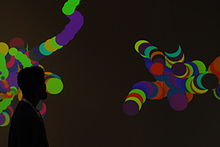- National Institute of Design, Gandhinagar
-
National Institute of Design (PG Campus) 
Established 2004 Type Autonomous National Institution Director Shri Pradyumna Vyas Academic staff 13 Postgraduates 60 Location Gandhinagar, Gujarat, India Campus Urban Type Design School Website www.nid.edu The National Institute of Design (राष्ट्रीय डिज़ाइन संस्थान) better known as NID is the foremost design Institute in India. Currently an extension campus of the parent institute , NID Gandhinagar is situated in the city of Gandhinagar. The IT integrated design discipline of New Media Design (NMD), and four other disciplines namely Strategic Design Management (SDM), Lifestyle Accessory Design (LAD), Toy and Game Design (TGD), Apparel Design and Merchandising (ADM) and . The future plans include shifting all the Post graduate disciplines to this campus and starting new courses for jewellery design and automobile design.
Contents
Academic programs
Toy and Game Design
The Toy and Game Design programme is offered to graduates in specific disciplines having a creative bent of mind, a sense of humour and fantasy, and a strong inclination towards play. This programme is multidisciplinary in nature. It encompasses elements from industrial design, animation and graphic design, human psychology and interaction, sociology and management domains. The programme commences with courses in Play Theory, Cognitive Ergonomics, Colour and Composition, Material / Media Technology, Study of Forms, Aesthetics, and Design Management, which provide the basic design foundation. Specialised inputs are also given to develop skills in forms and movement, character design, strategy building and multisensory design. Inputs in user understanding, technology, systems thinking and scenario building are provided as a part of projects. An understanding of interactive play experiences is emphasized on, during the initial period in which students are encouraged to take on a variety of design projects related to the broad spectrum of toy and game design. This helps the students to choose projects in areas of their choice at the senior level. Training modules in industries, institutions and heritage sectors provide major field level exposure.
NID has added game in its curriculum keeping in mind the growing market need and its applications in the areas of education, training, simulation and entertainment. Graduates of this programme are equipped to work with established toy and game industries in areas of mass manufactured toys, play equipment, table top games and digital games.
Lifestyle Accessory Design
The Lifestyle Accessory Design (LAD) post-graduate programme educates and trains professional designers to visualise and create lifestyle accessories and systems using different materials, processes and technologies. The designers from this programme aspire to drive the market and make ‘Designed in India’ a premier global brand. The programme focuses on a wide spectrum of accessory products to suit the needs of contemporary patterns of living and lifestyles. It relates to people’s living habits and the products they interact with which form an important basis of their day to day lives. It delves into perception and trend studies of diverse dynamics influencing the lifestyles of consumers from various strata of society. It offers a strong multidisciplinary edge wherein the students get opportunity to work with a wide spectrum of product categories - jewellery, bags, luggage, footwear, lighting, furnishings, furniture, space accessories and automobile interiors.
The programme curriculum encourages students to develop alternative approaches to designing products by building innovative, out-of-the-box thinking skills while ensuring that the design solutions successfully accomplish their commercial expectations. Design projects, which are actively plugged into the curriculum, provide a vital learning experience whereby the students exhibit their capability to converge and synthesize their creativity, skills and knowledgebase to come up with tangible outputs. A plethora of rewarding career opportunities are available to LAD graduates across diverse industry segments where a growing number of alumni are meaningfully contributing.
Apparel Design and Merchandising
The Apparel Design and Merchandising Programme is concerned with all those aspects of design, technology and merchandising required to create, produce and market clothing and fashions. It aims to develop a professional and creative attitude to the ever-changing needs of the apparel and fashion industry. The course enables students to question basic assumptions, challenge conventional wisdom and existing ways of doing things, and meaningfully explore possible alternatives. It is designed to prepare the student to be visually sophisticated. The programme lays emphasis on ready-to-wear, work and protective wear and costume design. The strength of the course is its close interaction with the textile discipline, which enables students to develop sensitivity to the very nature of cloth.
Students study design, production and management, as well as textile technology. Practice is supported by historical and theoretical studies. The programme is structured to take students through all aspects of apparel design like patternmaking, draping, sewing, construction of fabrics, knitting, knitwear design, marketing, merchandising and garment manufacturing technology. Students undertake fashion projects from the initial design stage to the finished garment. They are also given exposure to designing accessories such as jewellery, bags, footwear, belts and headgear. Graduates of this programme can seek work in the four broad areas of clothing: ready-to-wear, high fashion, costume design and functional wear. Several graduates are working as entrepreneurs, having set up their own design and production units.
New Media Design
The New Media Design programme at NID attempts to critically examine the relationship between technology and culture. Media, old and new, such as print, radio, television, internet, virtual reality, gaming and mobile telephony, to mention a few, have a profound impact on our culture. Understanding these various media and the impact they (may) create is crucial to understanding how our societies are shaped. This aspect is an essential component of New Media studies.
Students on the New Media programme spend the first semester on design fundamentals, which primarily involves studying various ‘mediums’, such as paper or print, photography, World Wide Web, along with broader issues in design such as ergonomics, form and typography. Specific inputs in new media studies are imparted and the semester ends with a design project investigating the application of new media in a specific context - for example the role of both analogue and digital media in classroom education in primary and secondary schools in India. The subsequent two semesters focus on design projects investigating the role of various mediums in, for example, education, healthcare, environment, craft and heritage preservation. As New Media Designers who will inevitably deal with the design of digital artefacts, the students are grounded in the fundamentals of interaction design. The fourth semester or Diploma, is where an area of interest, usually in collaboration with industry, is chosen for research.
The programme is transdisciplinary in nature, applying and integrating knowledge from various disciplines. In this sense, it is a unique combination of art, science and technology.Theprogramme seeks students from diverse backgrounds ranging from fine and applied arts, architecture, design, science, engineering or technical backgrounds. A willingness and motivation to learn various digital skills such as electronics, software programming, advanced 3D modelling, etc. is required.Strategic Design Management
Design is rapidly becoming the key to differentiation, premium realisation and brand positioning. The need for strategically managing design becomes significant in the job description of not only managers but also designers. Since NID has a spectrum of design faculties and disciplines, a multidisciplinary approach is more inherent in the scheme of things here than in any other business school. The Strategic Design Management programme is aimed at enabling the students to develop design leadership and entrepreneurial skills, and empower them to become wealth creators in the field. The programme will help students to generate strategies that enable the use of design for creating desired value, perception and differentiation.
As a design manager, a person is involved with strategies, action plans and processes. Critical functions such as innovation, new product development, packaging, retail impact, competitive analysis, design measurement, sustainability and customer delight issues are in the ambit of the Design Manager. It also involves design research, scenario building and trend forecasting, creating a right design mix, branding and design communication strategies. Students who complete the programme successfully will be well equipped to enter any industry or consultancy as strategic designers, design entrepreneurs, design managers, contributing either as team members or as team leaders.
External links
Categories:- Universities and colleges in Gujarat
- Indian design
Wikimedia Foundation. 2010.


